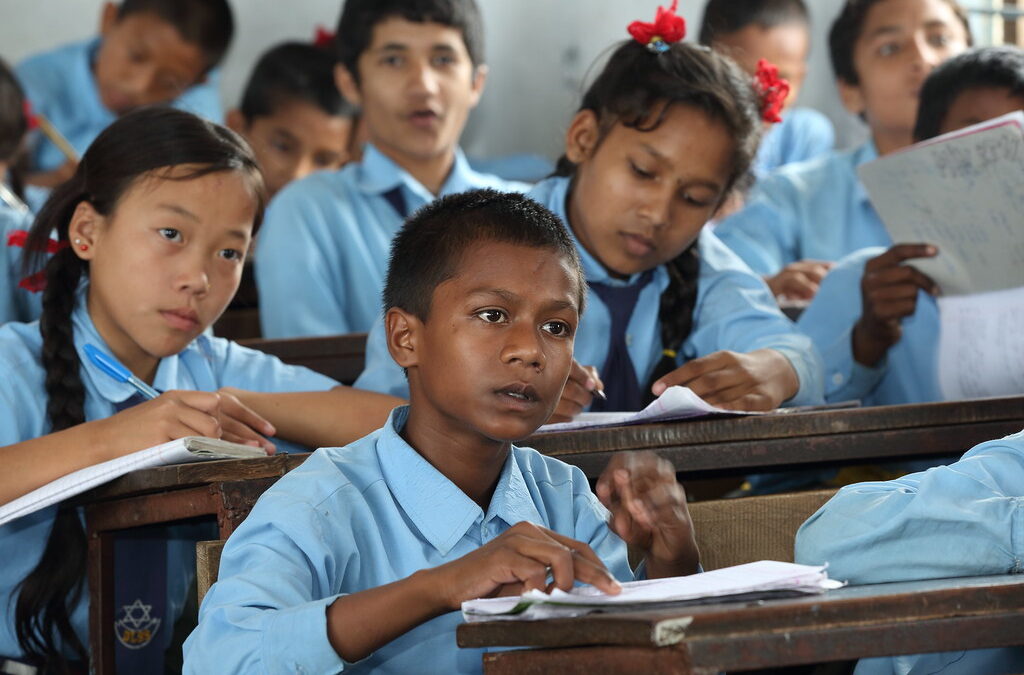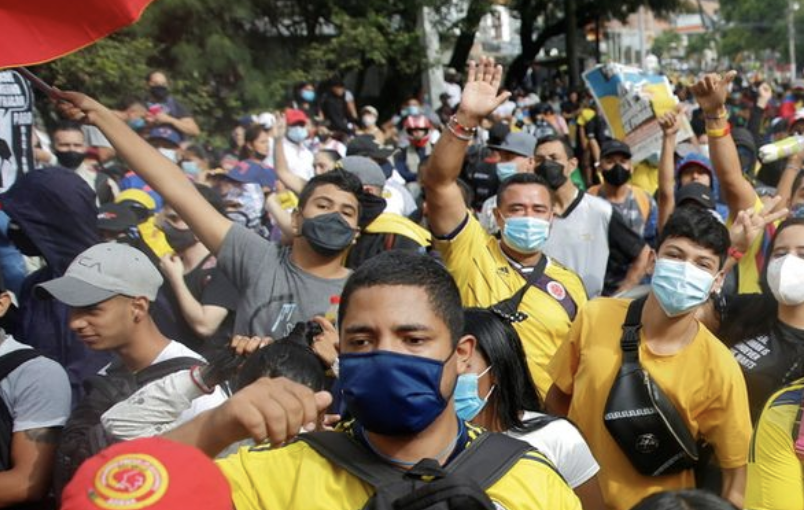
Late as usual: Delayed delivery of textbooks infringes the right to education of Nepali students
This op-ed was written by the ICJ’s Karuna Parajuli and Timothy Fish Hodgson. It was published on 10 June 2022 by the Kathmandu Post.

This op-ed was written by the ICJ’s Karuna Parajuli and Timothy Fish Hodgson. It was published on 10 June 2022 by the Kathmandu Post.

An opinion piece by Mathuri Thamilmaran, National Legal Advisor – Sri Lanka at the International Commission of Jurists. You can also find it in Sinhala and Tamil.

An opinion piece by Massimo Frigo, ICJ Senior Legal Adviser, Europe and Central Asia Programme.
On 25 May 2021, the Grand Chamber of the European Court of Human Rights issued a landmark ruling on the compatibility of systems of mass surveillance with the European Convention on Human Rights (ECHR), the essential elements of which were first brought to public light by the revelations of whistleblower Edward Snowden in 2013.
The judgment in the case brought against the United Kingdom, challenged both the system of bulk interception of cross-border communications set up by the UK, such as the Tempora programme, and the cooperation in bulk interception and surveillance with other countries. Most importantly among these countries are the so-called ‘Five Eyes’, i.e. the United States (using programmes such as UpStream and PRISM), Canada, Australia, New Zealand and the UK.
Given the complexity of the judgment, this blog article will limit itself to conveying the gist of the Strasbourg judges’ ruling with regard to its findings on compatibility with Article 8 ECHR protecting the right to privacy, and to setting out some first impressions.
Overall, while the Court has provided some useful standards in relation to mass surveillance online, the judgment is affected by some key deficiencies that unfortunately limit considerably its contribution to provide a solution for the current human rights challenges in the digital sphere.
This much awaited judgment is a landmark ruling because the Court, for the first time, addresses the challenges of mass surveillance carried out not only on data but also on metadata. Metadata includes information left in the Internet such as the author of the information, the location, the subject, and other identifiers.
The Court recognizes that its jurisprudence of ten years ago or more, most of which is based on targeted surveillance on individual communications, cannot stand the test of the internet revolution, in which “lives are increasingly lived online” (para. 341). The Court recognises the centrality of metadata when dealing with the Internet, when it finds that “any intrusion occasioned by the acquisition of related communications data will be magnified when they are obtained in bulk.” (para. 342).
The consequence of this finding, for the majority of the Grand Chamber, is that end-to-end safeguards are needed, i.e. from the moment of collection of the data or metadata until the moment of cessation of the surveillance activity on a given set of information. Further, these safeguards should increase as bulk interception progresses, based on the assumption that the more advanced it becomes, the closer it gets to the individual and to the content, hence to “traditional” surveillance.
Based on this reasoning, the Grand Chamber looks at “whether the domestic legal framework clearly define[s]:
The Court affirmed that “the transmission by a Contracting State to foreign States or international organisations of material obtained by bulk interception should be limited to such material as has been collected and stored in a Convention compliant manner and should be subject to certain additional specific safeguards pertaining to the transfer itself” (para. 362). These are circumstances clearly set out in domestic law; ensuring that the transferring State has in place safeguards against abuse; heightened safeguards for material requiring special confidentiality; and independent control.
However, contrary to the standard set out in EU law and by the Court of Justice of the EU, “[t]his does not necessarily mean that the receiving State must have comparable protection to that of the transferring State; nor does it necessarily require that an assurance is given prior to every transfer” (para. 362).
Finally, where intelligence surveillance concerns the UK’s request to obtain information or to search for information in the data or metadata acquired and stored by a third country, the Court forcefully stresses that these systems must not result in any circumvention of the requirements it has set out (para. 497).Therefore, requests can only be made if there is a basis in domestic law, which must be accessible and foreseeable and with clear rules “which give citizens an adequate indication of the circumstances in which and the conditions on which the authorities are empowered to make such a request … and which provide effective guarantees against the use of this power to circumvent domestic law and/or the States’ obligations under the Convention” (para. 497). In addition, there should be independent supervision and ex post facto review. Once the information is received, the standards set out by the Court for surveillance carried out by a Contracting Party to the ECHR must be applied.
As is evident, the Court has set some innovative standards to apply the Convention’s rights, in particular the right to privacy under article 8 ECHR, to the bulk interception of communications.
However, a closer analysis of the judgment – and in particular the separate opinions – shows that this landmark ruling misses the mark in the era of Big Data.
First, the judgment is vitiated by an implicit but excessive trust in the intelligence services and in the Government’s assessment that interception, storage, analysis and surveillance of data and metadata is essential to protect national security. The Grand Chamber’s majority does not attempt to assess the veracity of this sweeping assertion by the UK, with an application of the tests of necessity and proportionality, but relies blindly on it. This is a conceptual weakness, because once this premise is accepted, the judges’ reasoning builds on the primary need to make mass surveillance work.
Secondly, while the criteria established are useful and in part an improvement on its previous requirements, the Court has mostly conducted an assessment of the UK regulatory framework than of its actual, to the point that the Court found the existence of a legislation merely prohibiting the “circumvention of guarantees” to be an effective system to ensure that there is no circumvention of guarantees (see, para. 513).
Thirdly, it is problematic that some of the Court’s criteria for allowing for bulk interception can be overridden if, “when viewed as a whole, sufficient guarantees against abuse are built into the system to compensate for this weakness” (para. 370). This exception brings a degree of unpredictability to the system that in itself defeats the need to set out clear grounds for bulk interception. Both States and the Court are therefore allowed to carry out a case-by-case assessment for any kind of surveillance.
Fourth, one of the requirements of the legal framework gives up an essential guarantee of human rights protection, namely the oversight by the judiciary. While requiring that an independent authority be involved in the authorisation and ex post control processes, the Grand Chamber’s majority explicitly excludes that this must be a judicial authority and allows for “internal” authorities to be envisaged, even if they must be, at least on paper, “independent of the executive” (para. 359). On this specific point, the Court of Justice of the EU took a stronger position requiring the involvement of a judicial authority (see, Schrems II judgment, paras. 186-194).
With regard to foreign intelligence– whether the UK allows foreign intelligence services to obtain communications UK or the UK obtains or requests communications from foreign services – the Court applies lower standards and does not adopt the protection equivalency system that is provided by EU law. This means that it will be easier for the UK to request information from, for example the US National Security Agency, than to acquire it itself, with the only defence for privacy being an a priori faith in the letter of UK law, which states that “circumventing” national procedure is prohibited.
Finally, the Strasbourg judges have clearly avoided the central question of how to regulate forms of close transnational surveillance cooperation, such as that of the Five Eyes, that nurture and dispose of entire databases containing a high amount of the data produced on the Internet.
In conclusion, although the Grand Chamber’s ruling made modest advances in protecting human rights on the internet, overall it missed the opportunity presented by this case to address the technological revolution of the last decade, namely Big Data.
The Court has recognised the danger, but the solutions it has posited are still based on the logic of targeted surveillance systems, according to which the level of human rights protection should increase the more the surveillance is closer to the individual. Based on this logic, the more a CCTV camera closes on you the more guarantees you should have to protect your right to privacy.
However, the current Big Data system resembles more to an infinite set of cameras installed in everyone’s houses, which intelligence services can access on demand.
The failure by the Court to recognise and effectively regulate the moment of data gathering risks being fatal to the capacity of the guarantee established by the Court to effectively protect the human rights of people subject to this kind of surveillance.
It is to be hoped that the Court will revisit its jurisprudence in future cases to more effectively ensure that its jurisprudence provides effective protection to human rights in relation to the challenges brought by the technologies of today and not those of the past.
Disclaimer: This op-ed has first appeared on Volkerrechtsblog . The ICJ has intervened as a third party in the proceedings described.

According to the Ministry of Health (MOH), there are only 1,171 intensive care unit beds and 483 ventilators in government hospitals throughout the country. These are not enough to prevent serious illnesses and deaths, considering the ever-increasing number of patients requiring hospitalisation. Covid-19 designated public hospitals are already overwhelmed by patients, and private hospitals seem to be taking undue advantage of the crisis. The price lists for hospitalisation publicised by some private hospitals recently indicate the degree of profiteering they indulge in even as they remain out of bounds for a significant number of patients.
The pandemic has impacted a host of human rights, the right to health being the most prominent one. Under both national and international laws, Nepal is obligated to respect, protect and fulfil the right to health through measures that are non-discriminatory including based on social and economic status. This legal obligation requires the government to take effective measures to ensure the prevention, treatment and control of Covid-19. This also includes the duty to regulate the conduct of the private healthcare sector, including hospitals, pharmaceutical companies and laboratories.
Considering the nature of this pandemic, extraordinary measures need to be put in place to gather resources held by both public and private healthcare actors. These obligations must be pursued not only through individual laws, policies and practices of the state but also through collective international cooperation.
The government must take immediate policy measures through coordinated interventions, also involving the private sector to ensure people’s right to health. It must also reassess the existing legal and policy framework, reinvigorate a coordinating body, and develop an integrated plan. Public health professionals and management experts with the necessary power and resources should be included in decision-making to respond to the pandemic. Although the government had formed a Covid-19 Crisis Management Center (CCMC) last year, the Cabinet later started to take most of the decisions on its own, forcing the CCMC to exist only on paper.
The Health Ministry and local authorities must work in tandem to make health services accessible to everyone by increasing hospital beds, oxygen supply, medicines and other necessary equipment. Government authorities, including the Health Ministry, should, following the Supreme Court’s orders, ensure free and widespread access to Covid-19 testing to prevent further infections.
Efforts to fix the public health system should include a longer-term plan and progressive allocation of resources to increase the number of healthcare facilities with the necessary infrastructure and improve the quality of services. A need for an integrated legal framework was already highlighted during the first wave of the pandemic. The Supreme Court in August 2020 ordered the government to adopt specific integrated legislation providing a framework for different government organs to function effectively to prevent and respond to the pandemic.
However, in defiance of the order, the government has instead opted to coordinate its Covid-19 response through the ineffectual and antiquated Infectious Disease Act of 1964, which takes no account of contemporary human rights laws or Nepal’s recently devolved federal structure. The Act, therefore, does not provide guidance as to how different levels of the government (federal, provincial, and local) are obligated to ensure the right to health and in particular the prevention, treatment and control of pandemics as required under the international law. It also fails to provide a framework to hold health service providers, both public and private, accountable for infringing on people’s right to health.
Although the Public Health Service Act (2018) has many gaps, it was enacted to ensure access to health services by making them ‘regular, effective, qualitative and easily available’. Section 4 of the Act requires every health institution, whether public or private, to provide emergency health services and to make necessary arrangements for the treatment of patients with infectious diseases. In interpreting Section 3(4) C of this Act, the Supreme Court has indicated that health services for infectious diseases such as Covid-19 fall under the category of basic health services and should therefore be provided for free. The use of a rights-based approach should be the point of departure, guiding all efforts the government takes in addressing the pandemic.
No one should die while failing to get access to health services, which in some situations may amount to a violation of the right to life triggering criminal responsibility on the part of the state officials involved. International law also requires international cooperation, with countries helping each other in implementing the obligations related to the right to health. Nepal should ask for increased international cooperation and action at the international level, like the TRIPS patent waiver and other resources.
In the longer run, the pandemic should be heeded as a wake-up call to revamp the public healthcare system in Nepal. Moreover, reforms are needed to shield healthcare facilities from political interference. As the increasing nexus between political actors and private companies hampers a quality healthcare system and proper checks and balances, an effective mechanism needs to be put in place not only to investigate any allegation of corruption in public health institutions but also to look at issues related to conflict of interest.
Finally, an integrated law must be adopted to regulate and facilitate the work of public and private health sectors both, and provide a framework for appropriate monitoring mechanisms to ensure a free and accessible primary healthcare system without economic, social or any other form of discrimination.
First published in The Kathmandu Post here.

An opinion editorial by ICJ’s Commissioner, Rodrigo Uprimny. He presents seven measures to overcome the serious crisis Colombia is facing. He argues that authorities must make efforts to de-escalate violence and, in turn, escalate the protection of human rights.
The current crisis is severe. In a few days, more than 30 people have died, several of them from police bullets. There are also numerous disappeared persons. And there have been acts of extreme criminal vandalism, such as the attempt to incinerate several police officers inside a police station.
Apart from the severity, the crisis is complex. It is a result of a combination of old and new tensions, which have been accumulated and exploded due to a tax-reform bill proposal. But despite the complexity and severity, which make the crisis challenging to resolve, or perhaps precisely because of that, it is necessary to take measures to prevent the situation from getting worse.
The Government and political and social leaders must make efforts to deescalate violence. This requires escalating human rights, putting them at the centre of crisis management. So I propose seven measures oriented in that direction.
First, the president and, in general, all high-level government official must unequivocally condemn abuses by law enforcement officials. They must state that these acts will not be tolerated and will be investigated and punished. Unfortunately, those statements have not occurred.
Second, the organizers of the protests and those of us who share the protests must condemn not only the police abuses but also the acts of violence in the protests.
Third, the Office of the Ombudsperson and the Office of the Inspector General must remember that they are independent from the Government. They must take their independent role seriously. They must fulfil their constitutional function of defending human rights and denouncing abuses committed by authorities.
Unfortunately, despite the commitment of their officials, the interventions of these organizations have been weak due to the closeness of the Ombudsman and the Inspector General to the Government.
Fourth, authorities must identify and punish those who commit vandalism in the protests, especially against other people. At the same time, they must guarantee the right to peaceful protest, without stigmatizing the protest, and avoiding any excess in the use of force.
Thus, fifth, the Government and law enforcement officials must strictly comply with the ruling of the Supreme Court handed down in September 2020. In the ruling, the Supreme Court protected the right to peaceful protest and ordered authorities to refrain from stigmatizing the social protest and to adopt protocols to avoid excesses in the use of force.
Nevertheless, the ruling has not been applied in the ongoing protests. That is why several human rights organizations, including Dejusticia, filed a formal petition (incidente de desacato) against the Government.
Sixth, the Office of the General Prosecutor must investigate all violence committed during these protests, including those committed by the police, because if the crime is clearly contrary to the constitutional function of the law enforcement agencies, the case must go to the ordinary jurisdiction, in accordance with constitutional jurisprudence and with article 3 of Law 1407.
Seventh, the support of international human rights organizations should be sought. Consequentially, instead of obstructing the verification work of the Office in Colombia of the United Nations High Commissioner for Human Rights, as the Deputy Foreign Minister tried to do, the Government should facilitate the presence of other international bodies, such as the Inter-American Commission on Human Rights.
These measures and others of a similar nature, which put human rights at the centre of the crisis management, would help de-escalate the ongoing violence. At the same time, these measures would facilitate the necessary conversations to reach genuine national agreements on the ways to confront the underlying problems and tensions that fuelled the protests.
Notes:
Commissioner Uprimny is also Researcher at Dejusticia and member of the UN Committee on Economic, Social and Cultural Rights.
This op-ed was first published in Spanish in El Espectador on May 9, 2021